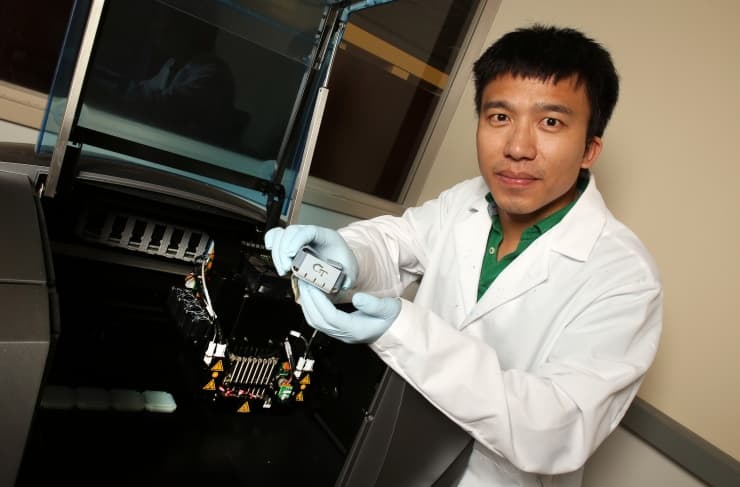4D Tech That Lets Complex 3D Objects Fold Themselves
Imagine an unmanned air vehicle (UAV) changing its shape from dive mission to cruise mission on-the-go in response to the result expected. Sounds uber cool, doesn't it? Now imagine a 3D object that can change its shape into a flat structure that can be rolled up for ease of transportation and changed to original 3D object at the destination. Those are the applications made possible by an all new 4D Technology developed by Georgia Tech and Singapore University (SUTD) researchers. They claim that their technology can be used to create 3D objects that can fold themselves from components that had been flat or rolled into a tube for shipment. These components will be so designed that they respond to variation in light, temperature or moisture to create space structures such as deployable robots, medical devices etc.

Yiqi Mao, a postdoctoral fellow at Georgia Tech showing a folded box structure created from smart shape-memory materials, which were created with the 3D printer.
To build this technology, the researchers from the two universities made use of SMPs or Shape Memory Polymers that can remember one shape and modify themselves to another pre-programmed shape when uniform heat is applied.
Such shape modifying objects that change shape in a controlled manner over time are created by printing multiple materials (using a 3D printer) with different dynamic mechanical properties in prescribed patterns throughout the 3D object. On applying heat uniformly, these SMPs respond at different rates to change the shape depending on their own internal clock. The researchers found that by controlling the time of the shape shift, 3D objects can be made to self-assemble aka fold themselves as and when needed.
In earlier efforts in this direction, multiple heaters were placed at specific regions in a component (SMP) and the on and off time was controlled for each heater. This is a rather complicated method for creating sequential shape changing components.
To make it simpler, in this research work, a spatially uniform temperature application technique was used to internally control their rate of shape change through their molecular design.
Companion finite element simulations were used to predict the responses of the 3D printed components, which were made from varying ratios of two different commercially-available SMPs. A simplified reduced-order model was also developed to rapidly and accurately describe the physics of the self-folding process.
A major issue with this technique however is that - self-folding involves avoiding of self-collisions. It may so happen that while where different parts of the folding structure contact and then block further folding process. To avoid this, the researchers developed a metric to predict collisions and have the 3D object fold only into the stable desired configurations without parts of its colliding.
What are your thoughts about this research work? Share with us in comments below.
Source: #-Link-Snipped-#

Yiqi Mao, a postdoctoral fellow at Georgia Tech showing a folded box structure created from smart shape-memory materials, which were created with the 3D printer.
To build this technology, the researchers from the two universities made use of SMPs or Shape Memory Polymers that can remember one shape and modify themselves to another pre-programmed shape when uniform heat is applied.
Such shape modifying objects that change shape in a controlled manner over time are created by printing multiple materials (using a 3D printer) with different dynamic mechanical properties in prescribed patterns throughout the 3D object. On applying heat uniformly, these SMPs respond at different rates to change the shape depending on their own internal clock. The researchers found that by controlling the time of the shape shift, 3D objects can be made to self-assemble aka fold themselves as and when needed.
In earlier efforts in this direction, multiple heaters were placed at specific regions in a component (SMP) and the on and off time was controlled for each heater. This is a rather complicated method for creating sequential shape changing components.
To make it simpler, in this research work, a spatially uniform temperature application technique was used to internally control their rate of shape change through their molecular design.
Companion finite element simulations were used to predict the responses of the 3D printed components, which were made from varying ratios of two different commercially-available SMPs. A simplified reduced-order model was also developed to rapidly and accurately describe the physics of the self-folding process.
A major issue with this technique however is that - self-folding involves avoiding of self-collisions. It may so happen that while where different parts of the folding structure contact and then block further folding process. To avoid this, the researchers developed a metric to predict collisions and have the 3D object fold only into the stable desired configurations without parts of its colliding.
What are your thoughts about this research work? Share with us in comments below.
Source: #-Link-Snipped-#
Replies
You are reading an archived discussion.
Related Posts
If you already haven't, it's time that you check the trailer for 'The Martian'. It's fabulously done -
The film is based on Andy Weir's 2011 novel The Martian.
Here...
Hailing from a city which is also known as 'academic town', Amit Vaish spent his building years in Roorkee. His father was a scientist at CBRI. "Engineering was very logical...
Quote:
Paul Graham is a renowned programmer and wildly successful venture capitalist. He also happens to be a talented writer.
I highly recommend you stop reading this and just go...
which is the best university for MS and has scholarship to do...i m an 3rd year B.tech IT student...
It was a great experience. Placements teaches a lot of things. One just needs to be content, cheerful and confident.
Accenture- The written test was conducted by Amcat- aspiring minds....
